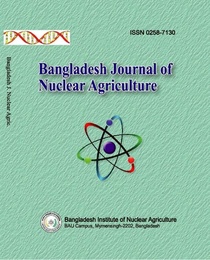FARMERS LEVEL ADOPTION OF BINA DEVELOPED CROP VARIETIES IN MYMENSINGH REGION OF BANGLADESH
Abstract
The study was conducted in Mymensingh agricultural region remaining four districts of Bangladesh to examine the farmers’ level adoption of BINA developed crop varieties. Primary data were used and those were collected from four districts through concerned DAE office and sub-stations of Bangladesh Institute of Nuclear Agriculture (BINA). Both tabular and descriptive statistical analysis was used to fulfill the objectives. The results showed that among the overall farmers level adoption of BINA developed Aus, Aman and Boro varieties, the highest area coverage was found in Aman 4.65% followed by Aus 0.26% and Boro 0.10%, respectively, The overall farmers level adoption of BINA developed pulse and oilseed varieties were 0.63% and 1.44%, respectively. The results also revealed that among the eight cropping pattern in Mymensingh agricultural region Boro-Fellow-Aman was the highest. It was found that farmers’ level adoption was highest by Binadhan-7 (15.86%) followed by Binadhan-17 (15.17 %), Binadahn-10 (10.74%), Binadhan-11 (10.69%), BRRIdhan-28 (9.97%), Binadhan-19 (7.07 %), Binadhan-14 (5.76%) and the lowest area was for BRRIdhan-29 (5.28%). Binasharisha-9 and vegetables were cultivated 15.55% and 3.91%, respectively. Results suggested that increasing trend of farmers level adoption of BINA varieties will contribute country’s total production as well as will support in achieving food security.
References
BBS, 2021. Statistical Yearbook of Bangladesh, Bangladesh Bureau of statistics, Statistics Division, Ministry of Planning, Govt. of the People’s Republic of Bangladesh, Dhaka. p.136.
Biro, K., Pradhan, B., Buchroithner, M. and Makeschin, F. 2013. Land use/land cover change analysis and its impact on soil properties in the Northern part of Gadarif region, Sudan. Land Degrad. Dev., 24: 90–102.
Hasan, et al., 2017. Projections of Future Land Use in Bangladesh under the Background of Baseline, Ecological Protection and Economic Development. Sustainability 2017, 9, 505.
Leh, M., Bajwa, S. and Chaubey, I. 2013. Impact of land use change on erosion risk: An integrated remote sensing, geographic information system modeling methodology. Land Degrad. Dev. 24: 409–421.
MoA (2018). Ministry of Agriculture, Agriculture for Development Strides, p. 5
Rahman, K.M.M. and Islam, M.A. 2014. Nutrition-sensitive agriculture in Bangladesh: a review. Food Security. 6: 671–683.
World Bank, 2020. World Bank, Washington, DC. https://openknowledge. worldbank.org.
Wu, X., Shen, Z., Liu, R. and Ding, Z. 2008. Land Use/Cover Dynamics in Response to Changes in Environmental and Socio-Political Forces in the Upper Reaches of the Yangtze River, China. Sensors, 8: 8104–8122.
-
Download



